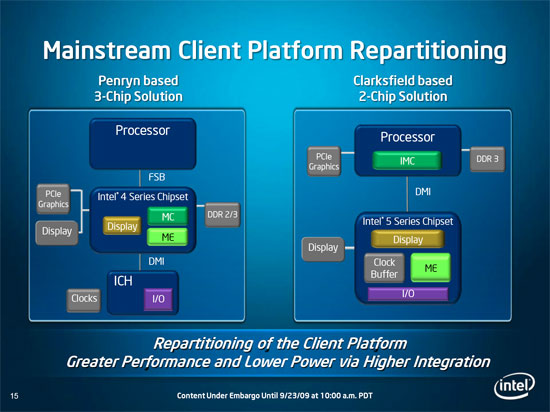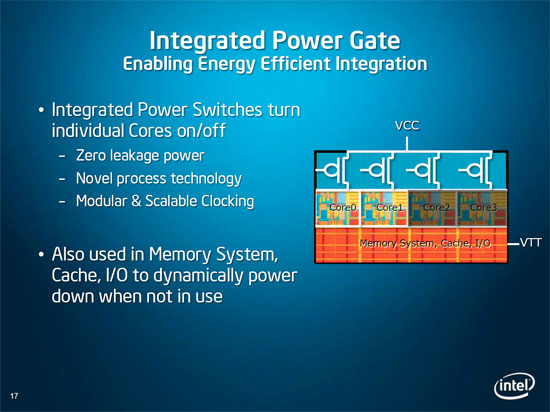Mobile Core i7 920XM, Clarksfield: Nehalem on-the-go
by Jarred Walton on September 23, 2009 10:00 AM EST- Posted in
- Laptops
Clarksfield Platform

As mentioned, Clarksfield bears a striking resemblance to Lynnfield. The core architecture is the same, and the chipset is essentially the same as well - it's just a mobile version of the P55 chipset, the PM55. The processor has an integrated memory controller and PCI-E x16 connection, while the PM55 chipset handles the rest.

One of the major benefits of Nehalem on the desktop is that it is extremely efficient when you're not taxing the CPU. This comes courtesy of Intel's Power Gate transistors, and as you would expect it's going to prove extremely useful on laptops. Now we can finally get high-performance laptop CPUs that don't kill battery life. If you are only doing minor document editing, your quad-core processor can just shut down three of the cores to conserve power.
We have noticed in testing that current quad-core CPUs require noticeably more power than dual-core parts, resulting in relatively poor battery life on any quad-core notebook. Clarksfield should help to address that issue, although the CPU can still consume quite a bit of power under full load. That's going to make things a little difficult, since we now have a CPU that can use very little power when idle but it can suck down as much - or more - power than a Core 2 Quad QX9300 at full throttle. That means Clarksfield is going to be destined more for desktop replacements as opposed to thin and light laptops; we'll need the dual-core Arrandale (the mobile equivalent of Clarkdale) before we see 35 W and 25 W mobile parts. (What we really want to see is Power Gate transistors used on GPUs…. Ed: Something that will be coming in the next couple of years)

One of the major innovations with Lynnfield is the aggressive Turbo modes, which allow you to get a quad-core processor that also works as an extremely fast dual-core or single-core CPU. The desktop i7-870 offers relatively impressive Turbo modes, allowing the CPU to scale from 2.93 GHz up to 3.6 GHz depending on what sort of load it's currently running. Put another way, the i7-870 can run at up to five bins above its rated clock speed. The mobile i7-920XM has a much lower base clock speed of just 2.0 GHz, but it has even more aggressive Turbo modes, allowing a single-core to scale up to 3.2 GHz - a boost of nine bins! The maximum dual-core boost is also much higher than on Lynnfield, allowing the i7-920XM to run at eight bins above stock with two active cores. Only with three or four active cores are the Turbo modes limited to a two-bin increase.










63 Comments
View All Comments
strikeback03 - Wednesday, September 23, 2009 - link
So when are we going to see Arrandale? At these prices not so interested in Clarksfield.strikeback03 - Wednesday, September 23, 2009 - link
Also, probably Dragon error:If you're after optimal gaming performance, obviously just kidding, the fastest CPU or the fastest GPU alone won't cut it in every situation.
bottom of page 7.
JarredWalton - Wednesday, September 23, 2009 - link
I have no idea what I was even trying to say on that one. Hmmm.... Dragon at 8AM after working for 20 hours straight is NOT my friend! :-) Oh, wait: "just getting" without the comma should work.As for Arrandale, it's due out in Q1 2010, so not too far off. 32nm and dual-core + Hyper-Threading should be very compelling I think.
strikeback03 - Thursday, September 24, 2009 - link
yeah, just getting is what I assumed it was.So no Arrandale before Christmas? That's too bad.
TA152H - Wednesday, September 23, 2009 - link
Finally a review conclusion I can agree with.Dual core with hyperthreading should be better. I also don't think laptops will replace desktops for gaming. Is Intel crazy? That's just such a strange prediction, I don't know why they would think it's even remotely possible.
I think they should have waited for 32nm before releasing a Nehalem for mobile. Really, they have no competition from AMD worth speaking about, and 32nm could have been done right - with an integrated IGP if desired, and low enough power use that it's not one hour and out.
A micro-ATX setup with a handle, a Bloomfield and a real video card would probably be better for the vast majority of gamers than this one. You don't get true portability, but with only one hour of life, you don't really get it with this either.
The gloom and doom for desktops is always overstated. For one, laptops are really only comfortable for women and weak, pencil-necked men. If you have any size, the keyboard is a nightmare, and none come with the natural keyboard which men's shoulder width really begs for.
On top of this, mouse movement is a pain in the neck with that replacement. A mouse is just more comfortable. Then you have to worry about power, which kind of ruins a lot of the fun with computers - just kind of doing what you feel like and relaxing. Who wants to worry about power? Then, you're limited by screens. Of course, you can dock these things, and use them as desktops, in which case they only have disadvantages (although not as many) in this role, and no advantages.
So, I think desktops will always be around, and always be the preferred tool even if you have both.
I think one reason laptops sell pretty well is, ironically, because they are unreliable, and need replacement much more often. They are also more difficult to upgrade, also necessitating replacement rather than upgrade. So, the reasons aren't all good.
Penti - Saturday, September 26, 2009 - link
To be fair it's a desktop replacement cpu, like their many released before. Yes it will replace desktops for gaming but only for some. DTR cpus are also used for high-end mobile workstations. It's not for everybody get your grip together. They don't do everything because competition from AMD.goinginstyle - Wednesday, September 23, 2009 - link
The cut and paste king is at it again."A micro-ATX setup with a handle, a Bloomfield and a real video card would probably be better for the vast majority of gamers than this one. "
You have to be kidding, Lynnfield offers far superior power management and consumption plus better overall performance than Bloomfield. Something you would actually want in a micro-ATX setup, instead of a heat generator like Bloomfield. Even the Phenom/Athlon II would make for a better micro-ATX gaming platform than the energy sucking Bloomfield.
Before you get on your high horse about Bloomfield and overclocking, it's not going to make any difference in a micro-ATX system compared to Lynnfield, except to make the temperatures unbearable.
How is that next cut and paste article coming along for Toms? Are you going to do the history of lawnmowers on this one?
TA152H - Wednesday, September 23, 2009 - link
Dude, are you gay or something? What is your obsession with me?Wouldn't your current boyfriend be upset if he saw your obsession.
Micro-Atx would, naturally, be plugged in. What kind of an idiot are you? Battery life wouldn't matter in this context. The micro-ATX would be for easy movement from one place to another. Some of them are really small, light (so even you could move it), and easily transported. I wasn't implying you'd want to use it from a battery.
Didn't you understand that within the context? Clearly, you're a moron. And a gay, obsessive one. Get a life. You need attention, clearly, but not from me. Find someone else.
goinginstyle - Wednesday, September 23, 2009 - link
What is your obsession with posting negative comments to every article at AT? They have proven you wrong every step of the way. Why they even wasted their time is beyond me but I have to hand it to them for even paying attention to you.You obviously do not make these sames posts at Toms? I just read through the comments on the last six or seven articles. Especially the cpu related ones and you did not make a single comment even though their conclusion, test methods, and information is nearly the same at ATs when comparing Lynnfield vs Bloomfield. Why is that?
You brought up the Bloomfield micro-ATX setup and I was just replying to one not so bright idea of yours about Bloomfield once again being superior. The last thing you want in a micro-ATX system you will be lugging around to LAN parties is a Bloomfield cpu and X58 chipset. Heat is thy enemy and this platform has ridiculous power consumption compared to Lynnfield or Phenom II. Considering the alternatives available I would say Bloomfield should be one of the last ones to suggest.
TA152H - Wednesday, September 23, 2009 - link
You're really not that stupid, are you?My post wasn't negative. I agreed with the author. I don't agree with Intel, and neither did he. What is your problem, besides liking me?
They didn't prove anything, at all. You're just too stupid to see through the weird benchmarking. Maybe I stopped reading before they posted their 'proof'. But, really, Anand's apple to apple benches proved my point. In their first article, they were saying they were the same or better. Then, all of the sudden, the Bloomfield is 3.5% faster, normalized! Sometimes almost 10%, on real world benchmarks. Fancy that! Although, this time they screwed up by making the Bloomfield uncore faster, so it's not 100% accurate.
Tom's also showed a lot of advantages of the Bloomfield. This site just rubbed me the wrong way because they were doing whatever they could to make the Lynnfield look better than it really is. Is 3% a big deal? Who knows? Maybe it is, maybe it isn't. That's a matter of perspective. But, when I see 0%, or -1%, and I know it's just not so, that's where someone has to say something. If they were arguing 3% isn't so important, then, so be it. But, show the 3%, instead of hiding it behind bogus setups that hide it.
You wouldn't understand because you're simple. But, life isn't simple. Very few things are good or bad, completely.
By the way, why would power matter more for micro-ATX than for anything else? The Bloomfield is king of the hill. I'm not crazy about the power use, really, I'm not, but, for a gaming platform, I'd want the best. I'd put up with the additional power use.
For a computer I'd put in the kitchen and would only surf on, I'd probably be much more inclined to look at power. Of course, even then I wouldn't consider the Lynnfield. I'd get a Core 2 or Pentium, a G45, and get all the performance I needed.
Also, you probably didn't notice, because Gary hid it, that the voltage needed to overclock the Lynnfield was considerably higher than the Bloomfield. That makes me a little nervous. But, still, I agree completely the x58 needs to go on a diet. I wish Intel would move it down to 45nm. It's a high end platform, it deserves it.
So, it's not the size, it's the application. Hmmmm, that could have a different context, but, remember we're talking about computers here.